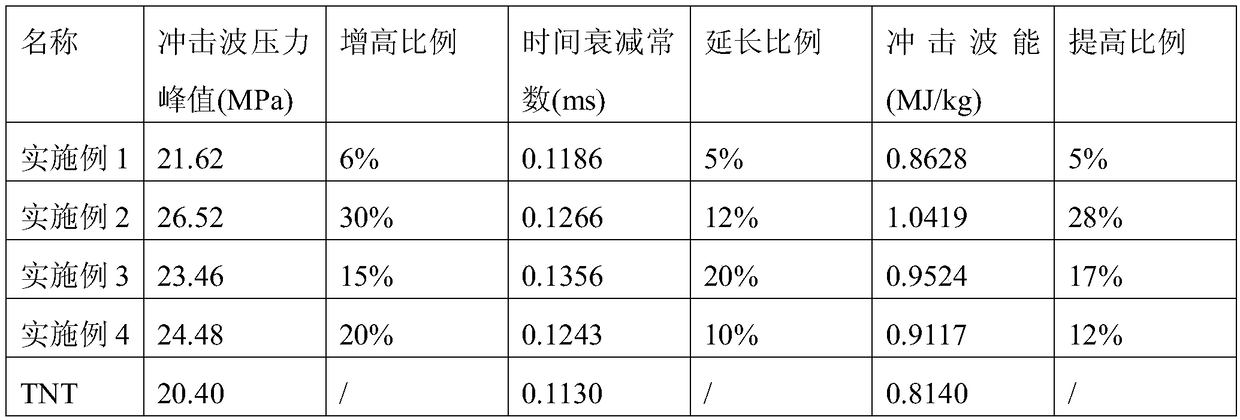A method for designing the energy of high shock wave energy explosive for underwater use
A design method and shock wave technology, applied in explosives, design optimization/simulation, calculation, etc., can solve problems such as rapid chemical reaction, obvious chemical compatibility problems, etc., and achieve the goal of improving research level, reducing research cost, and reducing test intensity. Effect
- Summary
- Abstract
- Description
- Claims
- Application Information
AI Technical Summary
Problems solved by technology
Method used
Image
Examples
Embodiment 1
[0024] Step 1, screening the composition of underwater explosives, the composition of designed underwater explosives is: aluminum powder / TNT / dioctyl phthalate (DOP)=15 / 79 / 6 (mass percentage ), the simplified chemical structure is C 2.805 h 2.325 N 1.044 o 2.150 al 0.556 , wherein the ratio of the moles of Al atoms to the moles of O atoms is 0.258;
[0025] Step 2, according to the composition of the underwater explosive designed in step 1, input the thermodynamics such as the theoretical density, standard molar enthalpy of formation, standard molar entropy, standard molar formation Gibbs free energy and molar heat capacity of aluminum powder, TNT and DOP Data, use the Becker-Kistiakowsky-Wilson state equation to perform thermodynamic calculations on the composition of the detonation products of the underwater explosive designed in step 1, and obtain the pressure-specific volume result curve of the detonation products under isentropic conditions, and use Levenberg-Marquardt...
Embodiment 2
[0031] Step 1, screening the composition of underwater explosives, the composition of designed underwater explosives is: aluminum powder / CL-20 / dioctyl adipate (DOA)=21 / 77 / 2 (quality percentage), the simplified chemical structure is C 1.174 h 1.282 N 2.110 o 2.131 al 0.778 , wherein the ratio of the moles of Al atoms to the moles of O atoms is 0.365;
[0032] Step 2, according to the composition of underwater explosives designed in step 1, input the theoretical density, standard molar enthalpy of formation, standard molar entropy, standard molar Gibbs free energy of formation and molar heat capacity of aluminum powder, CL-20 and DOA Wait for the thermodynamic data, use the Becker-Kistiakowsky-Wilson state equation to perform thermodynamic calculations on the detonation product composition of the underwater explosive designed in step 1, obtain the pressure-specific volume result curve of the detonation product under isentropic conditions, and use genetic optimization The al...
Embodiment 3
[0038] Step 1, screening the composition of underwater explosive, the composition of designed underwater explosive is: aluminum powder / RDX / epoxy fatty acid butyl ester (EBST)=22 / 75 / 3 (mass percentage), The simplified chemical structure is C 1.199 h 2.383 N 2.027 o 2.052 al 0.815 , wherein the ratio of the moles of Al atoms to the moles of O atoms is 0.397;
[0039] Step 2, according to the composition of the underwater explosive designed in step 1, input the thermodynamics such as the theoretical density of aluminum powder, RDX and EBST, standard molar enthalpy of formation, standard molar entropy, standard molar Gibbs free energy of formation, and molar heat capacity Data, use the Kihara-Hikita-Tanaka equation of state to perform thermodynamic calculations on the detonation product composition of the underwater explosive designed in step 1, and obtain the pressure-specific volume result curve of the detonation product under isentropic conditions, and use Levenberg-Marquar...
PUM
 Login to View More
Login to View More Abstract
Description
Claims
Application Information
 Login to View More
Login to View More - R&D
- Intellectual Property
- Life Sciences
- Materials
- Tech Scout
- Unparalleled Data Quality
- Higher Quality Content
- 60% Fewer Hallucinations
Browse by: Latest US Patents, China's latest patents, Technical Efficacy Thesaurus, Application Domain, Technology Topic, Popular Technical Reports.
© 2025 PatSnap. All rights reserved.Legal|Privacy policy|Modern Slavery Act Transparency Statement|Sitemap|About US| Contact US: help@patsnap.com

